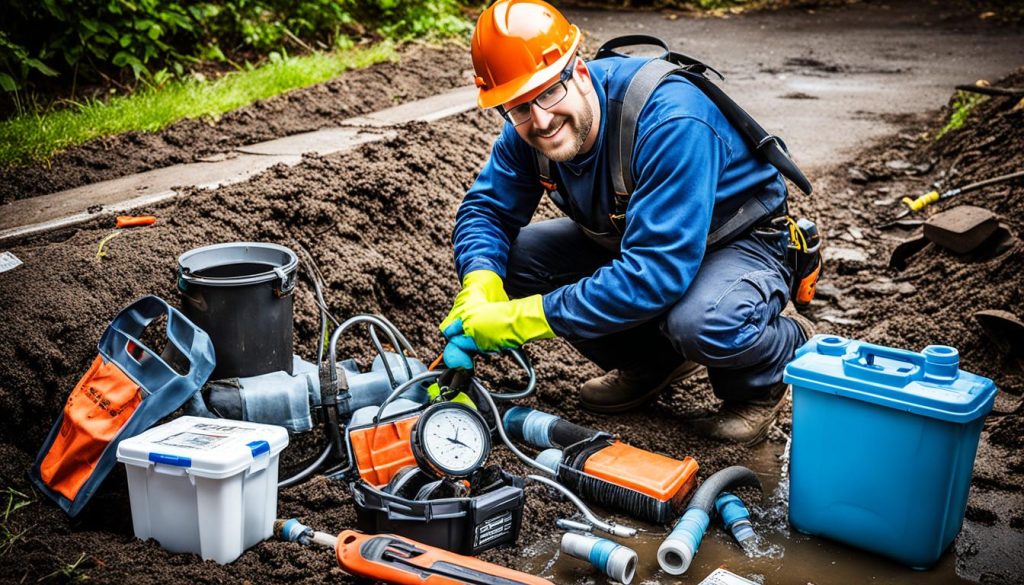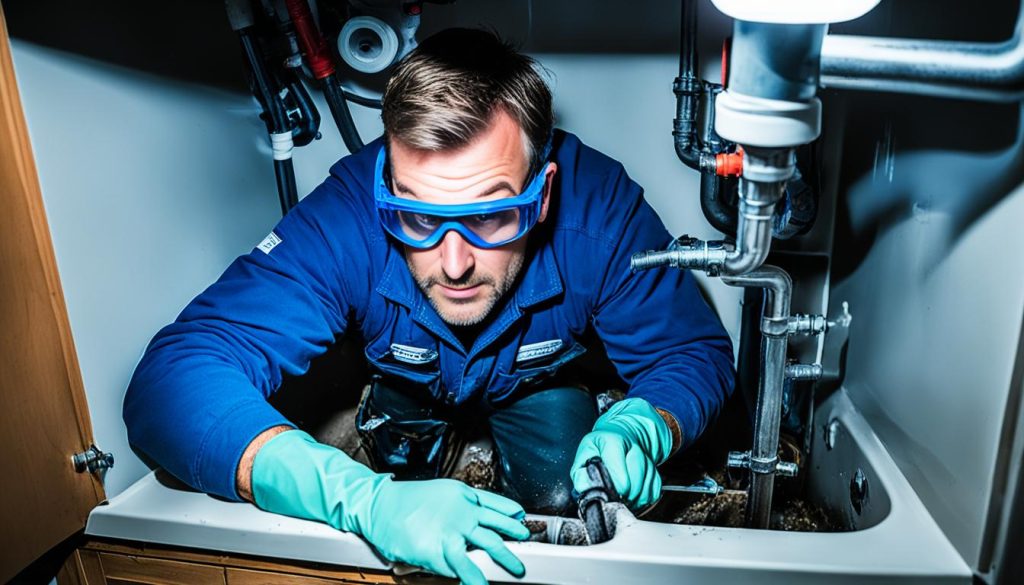Expert Guide: Rodding a Drain Simplified
Did you know that clogged drains account for nearly 75% of plumbing service calls in Canada? It’s a frustrating and common issue that can disrupt your daily routine and lead to costly repairs if left unaddressed. Thankfully, there’s a simple and effective solution: drain rodding.
Drain rodding is a method used to clear blocked drains and pipes, and it’s a technique that every homeowner should know. In this comprehensive guide, I’ll walk you through the basics of drain rodding, explain how to choose the right equipment, and provide a step-by-step process for using drain rods effectively.
Key Takeaways:
- Blocked drains account for 75% of plumbing service calls in Canada.
- Drain rodding is an effective method for clearing clogged drains.
- Choosing the right equipment is crucial for successful drain clearing.
- Wearing safety gear and locating the blockage are important preparation steps.
- Using a combination of pushing, twisting, and pulling motions can clear stubborn blockages.
Understanding the Basics of Drain Rodding
Drain rodding is a common technique used to clear blocked drains and pipes. It involves the use of drain rods, which are rigid and made typically from materials like steel or fiberglass. These sturdy and strong rods can be screwed together and fed into the drain to dislodge and remove blockages effectively.
While drain rods aren’t flexible, they are designed to maneuver through the pipes and clear any blockages. They are particularly useful for minor blockages that can be cleared without professional assistance.
When using drain rods, it’s essential to understand how to operate them correctly. Here are some steps to follow:
- Assemble the drain rods by screwing them together until you have enough length to reach the blockage.
- Carefully insert the drain rod into the pipe, ensuring a secure connection between the rods.
- Use a twisting motion to navigate bends and help the rod move forward.
- When you reach the blockage, apply a combination of pushing, twisting, and pulling motions to break it apart and clear the pipe.
It’s important to note that while drain rods can be effective for minor blockages, more severe or stubborn blockages may require the expertise of a professional plumber. If your attempts to clear the drain are unsuccessful or if the blockage persists, it’s best to seek professional assistance to prevent further damage to your plumbing system.
To get a clearer idea of how drain rodding works, take a look at the image below:
Choosing the Right Equipment for Rodding
When it comes to clearing blocked drains, selecting the right equipment is essential for effective results. The use of drain rods can be highly effective in clearing minor blockages and keeping your drains flowing smoothly. Drain rods are typically made from a highly flexible material, allowing them to navigate bends and adapt to the different structures within your drainage system.
To enhance the functionality of drain rods, various attachments can be used. These attachments, such as a plunger or a corkscrew, can be easily connected to the rods to provide additional force and aid in breaking up stubborn blockages. The plunger attachment is particularly useful for creating suction and dislodging debris, while the corkscrew attachment helps in breaking apart solid obstructions.
If drain rods are not readily available, alternative tools like a drain auger or a plumbing snake can be used. A drain auger, also known as a drain snake or a plumbing snake, is a flexible tool that can be inserted into the drain to break up and remove blockages. It is manually operated and widely used by professional plumbers for more severe blockages.
The Benefits of Choosing the Right Equipment:
- Efficiently clears blockages in minor to severe cases
- Flexible drain rods adapt to the structure of the drainage system
- Attachments like plungers and corkscrews enhance the effectiveness of rod usage
- Alternative tools like drain augers provide a viable option for difficult blockages
| Equipment | Description |
|---|---|
| Drain Rods | Highly flexible rods for navigating bends and structures within the drain |
| Attachments | Plungers and corkscrews for breaking up and removing stubborn blockages |
| Drain Auger | A flexible tool used to manually break apart and remove severe blockages |
Preparing to Rod Your Drains
Before attempting to unblock a drain, it’s important to take necessary precautions and prepare yourself properly. Here are some key steps to follow:
Gather Safety Gear
Ensure that you have the right safety gear before starting any drain rodding work. This will protect you from potential hazards, including harmful bacteria and debris. The following safety gear is recommended:
- Gloves to protect your hands
- A suitable suit or coveralls to shield your body
Locate the Blockage
Identifying the exact location of the blockage is essential for effective drain rodding. There are a few methods you can use to locate the blockage:
- Check Common Problem Areas: Start by inspecting areas such as sinks, toilets, and drains that are experiencing slow draining or bad odors. These are often signs of blockages.
- Use a CCTV Survey: If the blockage is not easily identifiable, consider hiring a professional plumbing service to conduct a CCTV survey. This involves using a small camera to inspect the inside of the drain system and accurately locate the blockage.
Once you have located the blockage, you can proceed with the drain rodding process. Remember to follow proper techniques and guidelines to ensure safety and effective results.
The Step-by-Step Guide to Using Drain Rods
In this section, I will guide you through the process of using drain rods to clear blockages in your drains. By following these step-by-step instructions, you’ll be able to effectively insert drain rods, clear blockages, and utilize different motions to break apart and remove the obstruction from your pipes.
Step 1: Gather the necessary equipment
Before starting, ensure that you have all the required equipment readily available. This includes a set of drain rods, preferably made from a highly flexible material. The flexibility of the rods allows them to navigate through the twists and turns of your drain system.
Step 2: Assemble the drain rods
Screw together enough rods to reach the blockage. Make sure each rod is securely fastened to the next to avoid any separation or disconnection while in use.
Step 3: Carefully insert the drain rod
Position yourself near the drain opening and gently insert the assembled drain rod into the pipe. Take care not to force it, as this may cause damage to the pipes.
Step 4: Navigate bends and resistance
Use a twisting motion to help the drain rod navigate bends and push through any resistance. This twisting action assists in breaking down the blockage and allows the rods to progress further into the pipe.
Step 5: Break apart and clear the blockage
Once you have reached the blockage, use a combination of pushing, twisting, and pulling motions to break it apart and clear the pipe. Apply gentle pressure to dislodge the obstruction and gradually work it free.
Step 6: Utilize a plunger attachment
If the blockage proves to be stubborn, attaching a plunger to the end of the drain rod can provide additional force and agitation. This can help dislodge and remove the blockage more effectively.
Following these step-by-step instructions will allow you to effectively use drain rods for clearing blockages in your drains. Remember to always exercise caution and seek professional assistance if the blockage persists or if you are unsure about any aspect of the process.
Maintenance and Prevention: Keeping Your Drains Clear
Regular drain maintenance is crucial to prevent blockages and ensure the smooth flow of water through your pipes. By implementing a few simple practices, you can keep your drains clear and avoid costly plumbing issues in the future.
To start, perform regular cleaning of your drains by flushing them with hot water. This helps to remove any buildup of grease, soap scum, and other debris that can lead to blockages. Additionally, using natural cleaners, such as a mixture of vinegar and baking soda, can help break down any residue and keep your drains clean.
Another effective way to prevent blockages is by installing drain strainers. These affordable devices can be placed over your drains to catch hair, food particles, and other debris before they enter the pipes. Simply empty the strainer regularly to maintain its effectiveness.
Lastly, it’s important to inspect your drains on a regular basis. Look for any signs of slow draining, gurgling sounds, or unpleasant odors, as these can indicate potential problems. If you notice any issues, it may be wise to contact a professional plumber to address the problem before it escalates into a major blockage.
- Investing Wisely: How Windows & Doors in Boost Property Value and Financial Health - April 24, 2025
- The Financial Impact of Personal Injuries: Why Legal Help Matters for Business Owners - April 16, 2025
- The Hidden Financial Costs of Domestic Assault: What Business Owners Need to Know - April 16, 2025














